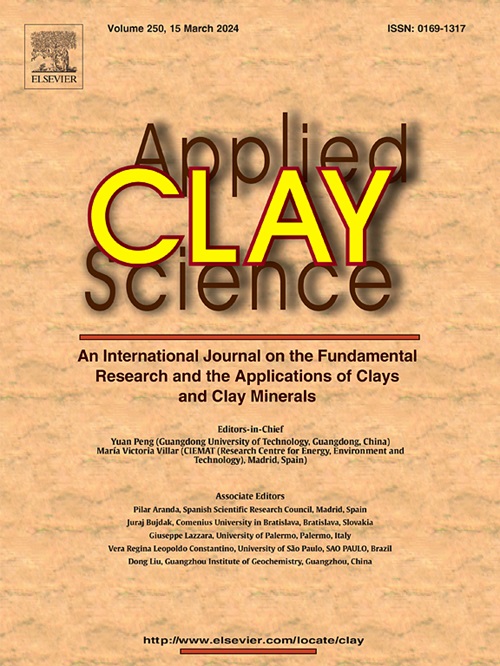昌马石窟页岩风化机制:对遗产退化的启示
IF 5.8
2区 地球科学
Q2 CHEMISTRY, PHYSICAL
引用次数: 0
摘要
有限的研究已经解决了页岩遗产的风化机制(定义为在人类历史上使用页岩岩性构建的遗迹),特别是在干旱和碱性环境中粘土矿物(页岩的主要成分)的转化途径。为了填补这一空白,本研究结合矿物学、地球化学、光谱学和显微学方法,对中国西北国家重点文化遗产昌马石窟的钙质页岩(CSH)和非钙质页岩(NCSH)的风化序列进行了研究。两种页岩在显微镜下显示出相似的层理结构和矿物类型,但CSH以大量白云岩为骨架,NCSH以粘土矿物为主。矿物学和元素分析表明,方解石溶蚀引发了两种页岩的风化,沉淀了石膏。长石风化在方解石溶解后立即开始。然而,两种页岩的粘土矿物转化存在差异:在NCSH中,黑云母和伊利石通过(氧化)溶蚀作用转化为伊利石/蛭石(I/V),而在CSH中没有观察到这种风化途径,可能是由于黑云母和伊利石较少,连接裂缝较少。绿泥石和斜长石可能在过去湿润环境和现代干旱气候中转变为伊利石/蒙脱石(I/S)。I/S和/或I/V引起的粘土膨胀破坏、石膏和方解石的盐风化以及裂缝发育显著恶化了当前气候条件下的石窟。这些损害的程度取决于水和氧气的供应情况。所提出的风化机制对于理解干旱和碱性环境下页岩风化和页岩遗产退化具有重要意义。本文章由计算机程序翻译,如有差异,请以英文原文为准。
Shale weathering mechanisms in the Changma Grottoes, NW China: Implications for heritage deterioration
Limited studies have addressed the weathering mechanisms of shale heritages (defined as remains built using shale lithology throughout human history), particularly the transformation pathways of clay minerals—the primary constituents of shale—in arid and alkaline environments. To fill this gap, this study combined mineralogical, geochemical, spectroscopic, and microscopic methods to examine the weathering sequences of calcareous shale (CSH) and noncalcareous shale (NCSH) at Changma Grottoes, a national key cultural heritage site in northwestern China. Both shales exhibited similar bedding structures and mineral types under the microscope, but CSH contained substantial dolomite as its skeleton, while NCSH was predominantly composed of clay minerals. Mineralogical and elemental analyses revealed that calcite dissolution initiated the weathering of both shales, precipitating gypsum. Feldspar weathering started immediately after calcite dissolution. However, clay mineral transformation differed between the two shales: in the NCSH, biotite and illite transformed to illite/vermiculite (I/V) through (oxidative) dissolution processes, while this weathering pathway was not observed in the CSH, possibly due to less biotite and illite and fewer connected fractures. Chlorite and plagioclase likely transformed to illite/smectite (I/S) in both shales in the past humid environment followed by the modern arid climate. Clay swelling damage caused by I/S and/or I/V, salt weathering of gypsum and calcite, and fracture development significantly deteriorated the grottoes under the current climate. The extents of these damages depended on availability of water and oxygen. The proposed weathering mechanisms are crucial for understanding shale weathering and deterioration of shale heritage in arid and alkaline environments.
求助全文
通过发布文献求助,成功后即可免费获取论文全文。
去求助
来源期刊

Applied Clay Science
地学-矿物学
CiteScore
10.30
自引率
10.70%
发文量
289
审稿时长
39 days
期刊介绍:
Applied Clay Science aims to be an international journal attracting high quality scientific papers on clays and clay minerals, including research papers, reviews, and technical notes. The journal covers typical subjects of Fundamental and Applied Clay Science such as:
• Synthesis and purification
• Structural, crystallographic and mineralogical properties of clays and clay minerals
• Thermal properties of clays and clay minerals
• Physico-chemical properties including i) surface and interface properties; ii) thermodynamic properties; iii) mechanical properties
• Interaction with water, with polar and apolar molecules
• Colloidal properties and rheology
• Adsorption, Intercalation, Ionic exchange
• Genesis and deposits of clay minerals
• Geology and geochemistry of clays
• Modification of clays and clay minerals properties by thermal and physical treatments
• Modification by chemical treatments with organic and inorganic molecules(organoclays, pillared clays)
• Modification by biological microorganisms. etc...
 求助内容:
求助内容: 应助结果提醒方式:
应助结果提醒方式:


